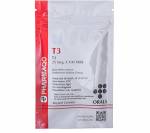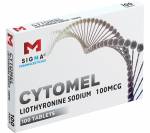Thyroid
Bitiron T3 and T4 Mix 12.5 mcg / 50 mcg
- Manufacturer:Abdi Ibrahim
- Brand Name:T4, L-thyroxine, Synthroid
$0.25
Liothyronine Sodium 25 mcg
- Manufacturer:Hilma Biocare
- Brand Name:T3, Tiromel, Cytomel
$44.00
Displaying 1 to 18 of 18 entries
The Thyroid, is an endocrine within the neck consisting of two connected lobes. The lower two-thirds of the lobes are connected by a skinny band of tissue called the thyroid isthmus. The thyroid is found at the front of the neck, below the Adam's apple. Microscopically, the functional unit of the thyroid is that the spherical thyroid follicle, lined with follicular cells (thyrocytes), and occasional parafollicular cells that surround a lumen containing colloid. The thyroid secretes three hormones: the 2 thyroid hormones – triiodothyronine ( T3), and thyroxine (T4), and a peptide hormone, calcitonin. The thyroid hormones influence the rate and protein synthesis, and in children, growth, and development. Calcitonin plays a task in calcium homeostasis. The secretion of the 2 thyroid hormones is regulated by thyrotropin (TSH), which is secreted from the anterior pituitary gland. TSH is regulated by TRH (TRH), which is produced by the hypothalamus.
The thyroid develops within the floor of the pharynx at the bottom of the tongue at 3-4 weeks gestation; it then descends ahead of the pharyngeal gut and ultimately over the subsequent few weeks, it migrates to the bottom of the neck. During migration, the thyroid remains connected to the tongue by a narrow canal, the thyroglossal duct. At the top of the fifth week the thyroglossal duct degenerates, and over the subsequent fortnight the detached thyroid migrates to its final position.
Thyroid disorders include hyperthyroidism, hypothyroidism, thyroid inflammation (thyroiditis), thyroid enlargement (goiter), thyroid nodules, and thyroid cancer. Hyperthyroidism is characterized by excessive secretion of thyroid hormones: the foremost common cause is that the autoimmune disease Graves disease. Hypothyroidism is characterized by a deficient secretion of thyroid hormones: the foremost common cause is iodine deficiency. In iodine-deficient regions, hypothyroidism secondary to iodine deficiency is the leading explanation for preventable intellectual disability in children. In iodine-sufficient regions, the foremost common explanation for hypothyroidism is that the autoimmune disease Hashimoto's thyroiditis.
The presence of the thyroid and its various diseases are noted and treated for thousands of years, although the gland itself has only been described and named since the Renaissance. Knowledge of the thyroid, its biochemistry, and its disorders developed throughout the late nineteenth and twentieth centuries. Many modern treatments and investigative modalities evolved throughout the mid-twentieth century, including refinement of surgical techniques for thyroid removal (thyroidectomy) for the treatment of goiter; the utilization of radioactive iodine and thiouracil for the treatment of Graves' disease; and fine-needle aspiration for diagnosis of thyroid nodules.

















